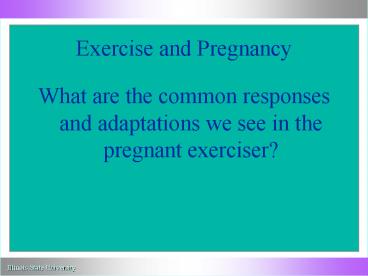Exercise and Pregnancy PowerPoint PPT Presentation
1 / 39
Title: Exercise and Pregnancy
1
Exercise and Pregnancy
- What are the common responses and adaptations we
see in the pregnant exerciser?
2
(No Transcript)
3
Cardiovascular system
- Cardiac output
- rapid increase in 1st two trimesters
- levels off in 3rd
- 30-50 above normal
- increased stroke volume
- greater strain on heart during exercise
4
Cardiovascular system
- Blood flow distribution
- increased flow to surface
- increased renal, pulmonary, and uterine blood
flow - decreased total peripheral resistance and
increased peripheral blood flow - decreased venous return
- exercise helps with venous return
5
Cardiovascular system
- Blood pressure
- decreased SBP and DBP during 1st two trimesters
6
Cardiovascular system
- Blood volume
- increases 50 by end of 2nd trimester
- increased plasma volume
7
Pulmonary System
- Diaphragm elevates
- FRC decreases by 25 due to decreased ERV and RV
- hyperventilation occurs at rest due to increased
progesterone levels and changes in the threshold
of the respiratory centers.
8
Metabolic System
- Slight increase in blood acidosis
- Increase in resting VO2 and VCO2
9
Metabolic System
- Metabolic rate is increased
- Increased use of carbohydrates as fuel
- result
- increased VO2 at any given workload
- increased O2 debt (EPOC)
10
Musculoskeletal System
- Increased joint laxity (relaxin)
- Stretching and thinning of abdominal wall
11
Musculoskeletal System
- Forward shift in c of g and anterior rotation of
pelvis - Proprioception and coordination are adversely
effected
12
Benefits of Exercise to the Pregnant Woman
- 1. Facilitate a general feeling of well-being.
- 2. Control of body composition.
- 3. Maintenance or development of optimal posture.
- 4. Decrease in the minor discomforts of
pregnancy. - 5. Promotes pelvic floor strength.
13
Benefits of Exercise to the Pregnant Woman
- 6. Maintain or improve aerobic conditioning.
- 7. Maintain or improve strength and/or
flexibility. - 8. Facilitate general recovery after delivery.
- Decrease by 1/2 post partum recovery days.
- 9. Improved tolerance during delivery.
14
Benefits of Exercise to the Pregnant Woman
- 10. Improved physiologic adaptations to
pregnancy. - 11. Improved ability to dissipate heat.
- 12. Limits the pregnancy related increase in
peripheral insulin resistance.
15
Risks to the Mother
- 1. Risks of injury due to overuse.
- 2. Increased potential for fatigue.
- 3. Joint injury.
- 4. Redistribution of cardiac output.
- 5. Thermoregulatory problems.
16
Latest Research
- Most women increase body mass by 20 during
pregnancy.
17
Latest Research
- Supine exercise doesnt create abdominal hernias.
- Abdominal recover within 6 weeks.
18
Latest Research
- Cardiac remodeling occurs.
- VO2 Max higher 10-40 weeks post-partum.
19
Latest Research
- Birth occurs 5-7 days earlier.
- No increased incidence of premature birth.
20
Latest Research
- Higher rate of normal delivery.
- Quicker recovery post-partum.
21
Latest Research
- Decreased feelings of stress.
22
Latest Research
- Increased fitness and muscle tone.
23
Latest Research
- Improved bladder control.
24
Risks to the Baby
- A. Heat Stress
- 1. Heat stress and malformation (animal studies).
- 2. Heat stress and malformation in saunas in
humans during early pregnancy.
25
Risks to the Baby
- 3. With exercise there is an increase in skin
temperature with minor increases in core
temperature. - 4. Exercising studies have not shown the
correlation between heat stress and
malformation.
26
Risks to the Baby
- B. Oxygen Delivery
- 1. Animal studies show conflicting results.
- 2. Body can adapt to make-up for decreased blood
flow - increase hemoconcentration and better
extraction.
27
Risks to the Baby
- C. Fetal Heart Rate Changes
- 1. Conflicting results.
- 2. Increased HR during start of exercise then it
levels off.
28
Risks to the Baby
- 3. No adverse effects.
- 4. Trained women show less uterine blood flow.
29
Risks to the Baby
- D. Decreased Blood Flow
- 1. Animals suggest there is a relationship
between exercise and low birth weight.
30
Risks to the Baby
- 2. This does not seem to be a problem in
rationally trained women. - 3. No relationship between exercise and
miscarriage.
31
Guidelines for Exercise
- 1. Medical and exercise history of the
individual. - 2. Questions or unusual symptoms
- bleeding, dizziness,
- cramping, joint pain
- faintness, elevated blood pressure,
- STOP exercising and consult physician.
32
Guidelines for Exercise
- 3. Listen to your body.
- 4. Expect some discomfort.
33
Guidelines for Exercise
- 5. Exercise regularly.
- 6. Do not exercise vigorously in hot humid
weather.
34
Guidelines for Exercise
- 7. Do not exercise at all during an illness with
fever.
35
Guidelines for Exercise
- 8. Avoid high impact activities.
- 9. Drink plenty of fluids.
36
Guidelines for Exercise
- 10. Rise slowly from down positions.
- 11. ACOG recommends that the HR not exceed 140
bpm.
37
Guidelines for Exercise
- 12. Avoid the valsalva maneuver.
38
Guidelines for Exercise
- 13. Do not begin a new fitness program.
- 14. Follow basic fitness principles.
39
(No Transcript)

